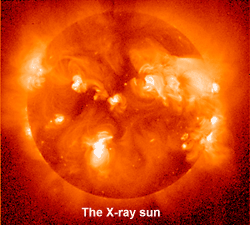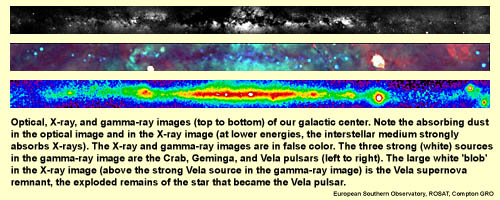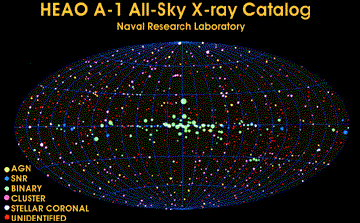AstroCappella: High Energy Groove
"X-ray Eyes..."
If you could look at the sky with X-ray eyes, what would you see?The visible portion of the spectrum from red through violet that we can see with our real eyes is only a small portion of the electromagnetic spectrum. Keep going past red to lower energies (i.e. lower frequencies) and you'll find infrared and radio. Go past violet in the other 'direction' and you'll be in the ultraviolet, and at even higher energies, X-ray and gamma-ray portions of the spectrum. You can learn this sequence painlessly, by singing along with the first verse of "High Energy Groove"!

X-rays are very useful to us here on Earth. You've probably had a bite-wing X-ray taken, with a film holder clenched in your jaw, so your dentist can check out your teeth. Perhaps you've had a broken arm or leg X-rayed so your doctor can see what's going on under the skin. For medical use, doctors tune their X-ray machines so that your bones absorb more X-rays than your skin. X-rays were discovered by Wilhelm Conrad Roentgen in 1895, who took the first 'X-ray' image ever of his (very trusting) wife's hand.
We don't X-ray the stars -- that's not what X-RAY ASTRONOMY is all about. Stars and galaxies are much too big and much too far away for that. The stars themselves emit the X-rays. We just collect them with our satellite detectors and analyze the data.
 An X-ray photon has an energy around 1000 times greater than an optical
photon, so the temperatures needed to produce X-rays are up in the
millions of degrees, in contrast to the more familiar stars with surface
temperatures of thousands of degrees. So when we look for X-rays, we're
basically hunting for very high-temperature gases, and other regions where
physical conditions are extreme (high densities, high gravitational
fields, strong magnetic fields). Until 1962, when a sounding rocket flight
detected bright X-rays from the constellation Scorpius, very few
astronomers believed that the universe contained objects capable of
generating large amounts of high energy radiation. (Check out that date
again - your teacher may be older than X-ray astronomy!)
An X-ray photon has an energy around 1000 times greater than an optical
photon, so the temperatures needed to produce X-rays are up in the
millions of degrees, in contrast to the more familiar stars with surface
temperatures of thousands of degrees. So when we look for X-rays, we're
basically hunting for very high-temperature gases, and other regions where
physical conditions are extreme (high densities, high gravitational
fields, strong magnetic fields). Until 1962, when a sounding rocket flight
detected bright X-rays from the constellation Scorpius, very few
astronomers believed that the universe contained objects capable of
generating large amounts of high energy radiation. (Check out that date
again - your teacher may be older than X-ray astronomy!)
If we flew above the atmosphere (which absorbs X-rays) and looked out at the cosmos with our X-ray eyes, the most obvious and beautiful thing we'd notice would be our Sun. We'd see an extraordinarily rich variety of loops, holes and bright spots associated with active regions in the X-ray emitting corona. (A Japanese satellite called Yohkoh took some stunning images of these features.) However, although the Sun is important to us, it's really a very average star. The Sun looks bright in X-rays because it's so close, but if we look further out, we'll find objects in the sky billions of times more powerful.

When we look out at our Milky Way galaxy with our ordinary vision, we see a truly milky band of stars. Looking more closely, we can see dust lanes in the Galactic center, where there appear to be fewer stars. Looking with our X-ray eyes, we'll see a large number of bright point sources, many of which are clustered along the central plane of the Milky Way -- these are X-RAY BINARIES, which we'll describe below. We'll see a bright band of more diffuse radiation from the central region of our Galaxy, which contains hot interstellar matter, and tens of thousands of little point sources that we can't determine individually. (We might not see the dust lanes -- the X-rays penetrate right through those.) Dotted around the sky we'll also see disks and broken rings, sometimes with bright centers -- these are SUPERNOVA REMNANTS, shells of material from stellar explosions, some of which contain rapidly-spinning PULSARS (again, see below) at their centers. The Crab Nebula is the remains of a supernova explosion in 1054 AD, which released energy equal to a hundred million nuclear warheads!
 The HEAO-1 X-ray astronomy satellite surveyed the sky in 1977-79, and detected the 842 bright sources shown here. They are displayed in "Galactic coordinates", which are similar to the latitude and longitude system we use on the Earth, with the plane of our Milky Way galaxy running horizontally along the center corresponding to our 'equator'. The bright X-ray sources are of a variety of different types, as indicated by the key on the left. Notice the way the X-ray binaries are clustered along and around the Galactic plane, while the stars and clusters are more uniformly distributed around us. |
"Powerhouses lighting up the Galaxy..."
Binary star systems contain two stars orbiting around their common center of mass. Many of the stars in our Galaxy are part of a binary system. X-RAY BINARIES are a special case, in which one of the stars is a compact, dense object like a NEUTRON STAR or BLACK HOLE, and the two stars are close enough that material is being pulled off the normal star by the gravity of the compact object. Due to its angular momentum, the incoming material often forms a flat disk around the compact star. The X-rays come from the inner regions of the disk, where the material has been heated to high temperatures, over a million degrees.A BLACK HOLE is a collapsed star so massive that neither light nor matter can escape. We can most easily detect them in X-ray binary systems, because of their interactions with the normal star. One of the best candidates for a black hole is Cyg X-1 (i.e. the brightest X-ray source in the constellation Cygnus). Discovered in X-rays in 1971, we know that the 'normal' star in the system is a bright supergiant, HDE226868, with a mass around thirty times that of our Sun, and that the binary period is 5.6 days. Combining this with the velocity of the supergiant around its orbit (which we measure using the Doppler Shift -- see the notes on "Doppler Shifting"!), we deduce that the compact object must be heavier than 15 solar masses - extremely massive.
A NEUTRON STAR is the imploded core of a massive star produced by a supernova explosion. Neutron stars are typically about 1.4 times the mass of our Sun, but are only ten miles across; so dense that a teaspoonful of neutron material would weigh more than a large mountain. Neutron stars cannot be more massive than three times the mass of the Sun, or they would collapse to become black holes. X-ray binaries containing neutron stars can be a lot smaller physically than those containing black holes -- size-wise, some neutron star binaries would fit comfortably inside our Sun. That bright source in Scorpius we mentioned above -- Sco X-1 -- is a neutron star binary.
Any humans approaching a neutron star (or a black hole) would be torn apart by the gravitational stresses, even if they could somehow be shielded from the extreme temperatures and the life-sterilizing X-ray emission. We know of around fifty X-ray binaries in our galaxy, and each produces way more energy in a single second than the total energy consumption of the United States this century.
And sometimes they get even brighter. Some binaries, called X-RAY BURSTERS, produce very short but very powerful bursts of X-rays over and above their normal output. These bursts last a few seconds, but produce as much energy as the Sun produces in its corona in 3000 years. The bursts are due to the sudden burning of the hydrogen from the normal star that has accumulated on the surface of the neutron star.
Some neutron stars -- the PULSARS -- have extremely powerful magnetic fields which channel the incoming material onto their poles. As the neutron star is spinning rapidly, we see fast pulses of X-rays. Some neutron stars rotate at a sedate pace of once every few minutes -- and others spin on their axis several hundred times each second!
And way beyond our Milky Way, we see extremely bright X-ray emission from the cores of some apparently-normal spiral galaxies, known as ACTIVE GALACTIC NUCLEI, or Seyfert Galaxies, after their discoverer, Carl Seyfert. Dwarfing even these are the immensely-distant (high-redshift) QUASARS. These active galaxies are the most distant things our X-ray eyes can see, and it's believed that each one harbors a supermassive black hole at its core millions of times more massive than our Sun.
